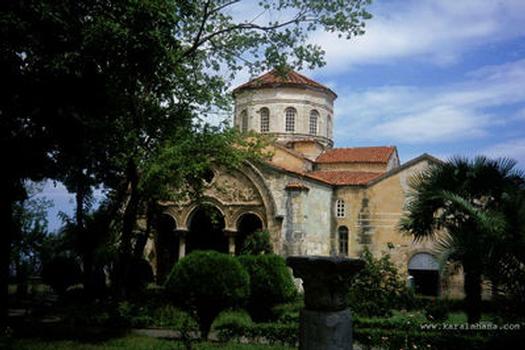General Information
Project Type
| Function / usage: |
Church |
|---|
Location
Technical Information
There currently is no technical data available.
Excerpt from Wikipedia
Hagia Sophia (Greek: Ἁγία Σοφία, meaning "Holy Wisdom" Turkish:Ayasofya) is a museum, formerly Greek Orthodox church which was converted into a mosque in 1584, and located in Trabzon, in the north-eastern part of Turkey. It dates back to the thirteenth century when Trabzon was the capital of the Empire of Trebizond. It is located near the seashore and two miles west of the medieval town's limits. It is one of a few dozen Byzantine sites still extant in the area. It has been described as being "regarded as one of the finest examples of Byzantine architecture."
History
Hagia Sophia was built in Trebizond during the reign of Manuel I between 1238 and 1263. The oldest graffiti carved in the apses of the church contain the dates 1291 and 1293. After Mehmed II conquered the city in 1461, the church was possibly converted into a mosque and its frescos covered in whitewash. Other scholars suggest it was not converted until 1584, being spared the initial transformation because it stood several kilometers outside the city walls. The monastery next door continued to be used by monks as late as 1701, when Tournefort found them still in residence. It is likely that the monks gradually abandoned a building that failed to protect them from harassment and predation, and the Turks assumed its use without needing to expel them.
During World War I and for a brief period afterward, the city was occupied by the Russian military and used as a makeshift hospital and depot. Afterwards it was put back into use as a mosque, until 1964 when it was turned into a museum - which it remains to this day. Between 1958 and 1964 the surviving frescoes were uncovered and the church consolidated with the help of experts from the University of Edinburgh and the General Directorate of Foundations; one expert involved in the work estimated no more than one-sixth of the original decorations had survived. All that did survive, however, are thought to be original works done just after its construction, and are considered part of the Byzantine 'Palaiologic Renaissance'.
The Hagia Sophia church is an important example of late Byzantine architecture, being characterised by a high central dome and four large column arches supporting the weight of the dome and ceiling. Below the dome is an Opus sectile pavement of multicolored stones. The church was built with a cross-in-square plan, but with an exterior form that takes the shape of a cross thanks to prominent north and south porches. The structure is 22 metres long, 11.6 metres wide and 12.7 metres tall. The late 13th-century frescos, revealed during the University of Edinburgh restoration, illustrate New Testament themes. External stone figurative reliefs and other ornamenting is in keeping with local traditions found in Georgia. 24 metres to the west of the church is a tall bell tower, 40 metres high. It was built in 1427 and houses a small chapel on its second floor. The internal walls of the bell tower are covered in frescoes. It was also used as an observatory by local astronomers.
Mosque conversion
In 2012, the religious authorities (Diyanet) filed a lawsuit against the ministry of culture, claiming the ministry had been 'illegally occupying' the church for some decades. The Diyanet won the case, getting ownership of the building. On 5 July 2013, the former church was partially converted for a while into a mosque according to the local Vakif Direction of Trabzon, which is the owner of the estate. The reconstruction works were started, in which some frescoes were veiled and the floor covered by a carpet. The mufti of the Turkish province Trabzon said that “the works for opening the Hagia Sophia mosque in the city to practice prayers again are going on,” and that “during the prayer the mural paintings will be covered by curtains". The local union of architects from Trabzon filed a lawsuit against the ministry of religious affairs' conversion plan. A local judge ruled the transformation of the former church to be illegal, and ordered it to be maintained as a museum.
Cultural significance
The church figures prominently and has key significance for the author's spiritual development in Rose Macaulay's novel The Towers of Trebizond.
Text imported from Wikipedia article "Hagia Sophia, Trabzon" and modified on 02 June 2020 according to the CC-BY-SA 3.0 license.
Participants
Currently there is no information available about persons or companies having participated in this project.
Relevant Web Sites
- About this
data sheet - Structure-ID
20030211 - Published on:
15/08/2007 - Last updated on:
28/05/2021





